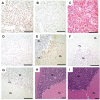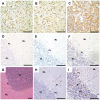Developmentally Arrested Basket/Stellate Cells in Postnatal Human Brain as Potential Tumor Cells of Origin for Cerebellar Hemangioblastoma in von Hippel-Lindau Patients
- PMID: 35980299
- PMCID: PMC9803908
- DOI: 10.1093/jnen/nlac073
Developmentally Arrested Basket/Stellate Cells in Postnatal Human Brain as Potential Tumor Cells of Origin for Cerebellar Hemangioblastoma in von Hippel-Lindau Patients
Abstract
von Hippel-Lindau (VHL) disease is an autosomal dominant hereditary cancer disorder caused by a germline mutation in the VHL tumor suppressor gene. Loss of the wild-type allele results in VHL deficiency and the potential formation of cerebellar hemangioblastomas, which resemble embryonic hemangioblast proliferation and differentiation processes. Multiple, microscopic, VHL-deficient precursors, termed developmentally arrested structural elements (DASEs), consistently involve the cerebellar molecular layer in VHL patients, indicating the tumor site of origin. Unlike hemangioblastomas, however, cerebellar DASEs do not express brachyury, a mesodermal marker for hemangioblasts. In this study, neuronal progenitors occupying the molecular layer were investigated as tumor cells of origin. By immunohistochemistry, cerebellar DASEs and hemangioblastomas lacked immunoreactivity with antibody ZIC1 (Zic family member 1), a granule cell progenitor marker with concordance from oligonucleotide RNA expression array analyses. Rather, cerebellar DASEs and hemangioblastomas were immunoreactive with antibody PAX2 (paired box 2), a marker of basket/stellate cell progenitors. VHL cerebellar cortices also revealed PAX2-positive cells in Purkinje and molecular layers, resembling the histological and molecular development of basket/stellate cells in postnatal non-VHL mouse and human cerebella. These data suggest that VHL deficiency can result in the developmental arrest of basket/stellate cells in the human cerebellum and that these PAX2-positive, initiated cells await another insult or signal to form DASEs and eventually, tumors.
Keywords: Developmentally arrested basket/stellate cells; Hemangioblastoma; Paired box 2 (PAX2); Tumor suppressor syndrome; VHL human cerebellum tumor cell of origin; von Hippel-Lindau (VHL) disease.
Published by Oxford University Press on behalf of American Association of Neuropathologists, Inc. 2022.
Figures







Similar articles
-
Developmentally arrested structures preceding cerebellar tumors in von Hippel-Lindau disease.Mod Pathol. 2011 Aug;24(8):1023-30. doi: 10.1038/modpathol.2011.61. Epub 2011 Apr 15. Mod Pathol. 2011. PMID: 21499240 Free PMC article.
-
Putative control of angiogenesis in hemangioblastomas by the von Hippel-Lindau tumor suppressor gene.J Neuropathol Exp Neurol. 1997 Nov;56(11):1242-52. doi: 10.1097/00005072-199711000-00009. J Neuropathol Exp Neurol. 1997. PMID: 9370235
-
Role of VHL-JAK-STAT signaling pathway in central nervous system hemangioblastoma associated with von Hippel-Lindau disease.J Neurooncol. 2020 May;148(1):29-38. doi: 10.1007/s11060-020-03506-8. Epub 2020 Apr 30. J Neurooncol. 2020. PMID: 32356150
-
Pathology, genetics and cell biology of hemangioblastomas.Histol Histopathol. 1996 Oct;11(4):1049-61. Histol Histopathol. 1996. PMID: 8930647 Review.
-
Von Hippel-Lindau disease: a single gene, several hereditary tumors.J Endocrinol Invest. 2018 Jan;41(1):21-31. doi: 10.1007/s40618-017-0683-1. Epub 2017 Jun 6. J Endocrinol Invest. 2018. PMID: 28589383 Review.
Cited by
-
Time course of tumorigenesis of a newly developed sporadic hemangioblastoma in an elderly patient: illustrative case.J Neurosurg Case Lessons. 2024 Apr 8;7(15):CASE23757. doi: 10.3171/CASE23757. Print 2024 Apr 8. J Neurosurg Case Lessons. 2024. PMID: 38588593 Free PMC article.
References
-
- Kim WY, Kaelin WG.. Role of VHL gene mutation in human cancer. J Clin Oncol 2004;22:4991–5004 - PubMed
-
- Latif F, Tory K, Gnarra J, et al.Identification of the von Hippel-Lindau disease tumor suppressor gene. Science 1993;260:1317–20 - PubMed
-
- Lamiell JM, Salazar FG, Hsia YE.. von Hippel-Lindau disease affecting 43 members of a single kindred. Medicine (Baltimore) 1989;68:1–29 - PubMed
Publication types
MeSH terms
Substances
Grants and funding
LinkOut - more resources
Full Text Sources
Medical

